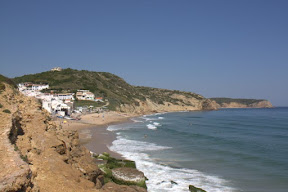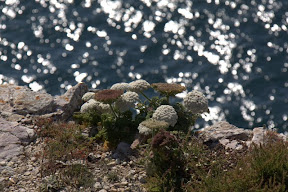Slovenia continued, continued.
Part three: Bovec/Soca River Valley
As magical as Bled was, I was rather drawn to Bovec and the Soca River Valley. To get there, we drove the Vrsic pass through the Julian Alps: a road built mainly by Russian WWI POWs with 50 hairpin turns rising up and then down again through the mountains.
When you land on the other side of the mountains, you are greeted by the Soca River, a river with clear pale turquoise waters.
There are a lot of little towns in the valley, but we especially liked Bovec, a town with less than 2,000 people that is surrounded by mountains on all sides. More on our adventures in Bovec to come.
Part four: Piran
It is hard to ignore the call of the sea, so we headed south to Piran, a quaint town smushed onto a peninsula jutting out into the Adriatic Sea. Very close to Italy, we heard just as much Italian as we did Slovenian. The rain did not let up for most of the time we were there, confining us mostly to our room or a coffee shop, but when it did shine, Piran woke up out of its slumber. We were befuddled by everyone’s proclivity to lay out on rocks or concrete. All seemed very uncomfortable, but I suppose if there is no beach, you make own of your own.
We liked Piran, but it didn’t seem to have a lot of things to do. There were not many shops, and most sold touristy junk. Most of the restaurants served the same types of food, including sea bass upwards of $40. Fish may cost $40 in places like Pittsburgh when it is flown in fresh from far flung places daily, but I couldn’t understand how fish could cost that much in a town next to the sea. I later read that the Adriatic Sea has been overfished, forcing fishers to go further and further away. Piran may be worth a visit if you have lots of time, but we think out of the places we saw, the best parts of Slovenia lie north.
Slovenia, continued.
Part Two: Lake Bled
One of the overused phrases in travel is picture perfect or just like a postcard. Yet I’m not sure what else one could say about Lake Bled. It has a small island in the middle of a lake, with a church built in the 1600s rising 99 steps above the lake. It has a castle up on a hill, overlooking the lake, and mountains on all sides. Even in the pouring rain, Lake Bled looked special. When the sun finally broke through the clouds in the early evening, it looked surreal.
Close to Bled is the Vintgar Gorge, where a rickety wooden path first built in 1893 leads you into the gorge alongside the rushing river. In places, the water was completely clear, and more often than not, it was a turquoise shade. It was really awesome.
Slovenia and Slovakia are two different countries.
Before we went on this trip, I must confess that I really knew absolutely nothing about Slovenia. For some unknown reason, I just assumed it was some provincial country in Eastern Europe and I never could keep it straight with Slovakia.
Apparently I am not the only one. We’re from the United States, I told the very friendly and chatty receptionist at one of our hotels. This is our first time in Slovenia. We didn’t know much about it before we came, but we really like it. She smiled and said, Oh, I am so glad you like it. Most people from the United States do not know the difference between Slovenia and Slovakia. Um, guilty, as charged. I guess it is all good though because when we told her we were from Pennsylvania, she asked if that was where Dracula was from.
Most of you are probably smarter than me, but in the off chance you have not kept up with your world geography since elementary school, let me introduce you to Slovenia. It became a country when it dissolved from Yugoslavia in 1991. I am not sure where I got the provincial idea from, especially considering Slovenia had the strongest economy in Yugoslavia, obtained membership in the E.U. in 2004, and in 2007, was the first former communist country to adopt the the euro. Slovenia borders Austria, Italy, and Croatia. Its landscape includes mountains (the Julian Alps in the northeast), lakes, caves, and a small coastline on the Adriatic Sea. Slovenia is a tiny country – most destinations can be reached from the capital, Ljubjlana, in a couple of hours. Yet even though we spent a week there, we didn’t see any of the eastern part of the country. For such a small country, Slovenia has a lot to offer.
Part One: Ljubjlana
For starters, the capital, Ljubjlana, is an adorable city made all the more easy to enjoy because of its big, yet small, size. It is by far the biggest city in Slovenia, but it only has about 300,000 people. (By the way, best we can tell, it is pronounced something like Lube-blahn-ya. Locals seemed to differ. It took us the better part of the week to figure out how to say it, which made it interesting when we were trying to ask if we were at the right train station. Is this Lub…um, where are we?) Lively bars and cafes lined the river. In the center of town, a trio of bridges crossed the river. There was some sort of festival going on when we were there, so every night you could take in a free outdoor ballet performance of Madame Butterfly. It has a large fruit market, which we heard expands on Saturdays. There are still some relics of communist buildings (such as the hotel in which we stayed our second night), but for the most part, Ljubjlana is an attractive city that definitely warrants a visit.
If you go, do check out Compa, which serves homemade beer and a mean platter of grilled meat, vegetables and cheese. Don’t check out Hostel Most until their renovations are finished. For some crazy reason, we took a room there and we even saw it first. Located along the river, it will be very nice when it is finished. They are actually renting out unfinished rooms. And people are actually stupid enough to pay for them (albeit getting a discount). I guess it didn’t occur to us to keep looking because prior to the trip, we grew accustomed to living in a state of disarray. It didn’t take long to start having flashbacks to our four years of renovations, most of which were spent living much like Hostel Most: dirty floors, no baseboard or casing, wires sticking out of walls, plastic sheeting hanging from the walls, and drywall dust everywhere. Sean says I was starry eyed over the magic words: private bath, free wifi, and discount. When we realized we had no place to hang our laundry to dry in fear that it would touch the floors, and that we were constantly wearing shoes in the room, we moved to a drab, communist looking hotel. We sold our house for a reason, after all.
Prague in pictures (aka we took 310 pictures in Prague, somebody has to look at them).
Nude Beach
 |
| From Western Algarve |
The Algarve area of Portugal is tailor made for exploring due to the many beaches lining the southern coast of Portugal. As you go west, many of the beaches are tucked in between rocky cliffs. After Tavira, we headed west to Salema, a small fishing village in the southwest corner of Portugal, upon the recommendation of our friends Brad and Rachel. We used Salema as a base to explore the other beaches. Salema itself is located down a green meandering country road that leads to the ocean. (Unfortunately, most of my pictures of the town were the ones located on the camera card in our stolen camera, but I do have some.)
Since our hotel room had a small refrigerator, counter, knife, cutting board and a couple of dishes we took advantage and made some of our own meals. It also had a corkscrew, allowing us to get our own bottle of Portuguese green wine for under 3 euros. Since the Algarve is renowned for its seafood, we made sure to eat out one night and tried cataplana, a delicious and flavorful stew with fish, shellfish, tomatos, peppers and lots of spices cooked in special cookware.
We spent one day beach-hopping. Unlike the crowded, commercial or residential beaches at home, most of the land leading up to the beaches is protected and undeveloped. We drove down country roads lined with wildflowers, never sure what type of beach would pop up at the end. We happened to hit on the best one first. Tucked into between rocky cliffs, the sand was softer than the beach we visited on an island in Tavira. We found a spot between some beach rocks and listened to the waves crash up against the rocks. The Atlantic Ocean’s waters were still too nippy to do much swimming, but some people surfed in wet suits. Sean and a few other swimmers braved the waters for a quick swim.
It didn’t take long to figure out that the beach was divided into segments. Closest to the road, families with children made sand castles and frolicked in a pool of water leftover from high tide. Further down, it seemed to be mostly adults. Like the beach at Tavira, some, but not all, of the woman chose to go topless. But at the end of the beach – the most scenic part next to the rocky cliff – we quickly realized that many people, both men and woman, were full on nude. The men in particular seemed to strut up and down the sand in this section of the beach, scholongs waving back and forth. The funny part about nude beaches is that most of the people who are nude or topless aren’t the ones you probably would want to see. In case you were wondering, we both don’t feel the need for a head to toe tan. With my luck, I’d get a nasty sunburn in a place where the sun doesn’t normally shine.


































